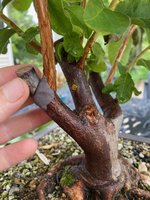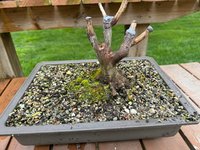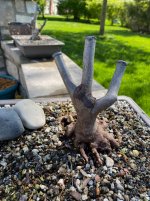LeftHandLuke
Shohin
I picked up this azalea at a discount in 2022, moved to training pot (first pic) in May of that year. I let it grow pretty much freely the first year and the trunk base / root flair / taper progressed nicely (second pic from July 2022). Last year I started the clip-and-grow process and I like where it's headed. Third pic is from last August. Third and fourth pics are from today. My question is: Should I repot now?
Water pools on top of soil and is sluggish to drain, although it does drain through bottom of pot. Soil has become somewhat compacted and I don't see a ton of feeder roots near the top after digging down a half-inch or so. I'm not sure what's underneath and hesitant to slip it out for a quick look. (Side note: This is the deciduous type of azalea.)
It's been in this pot for two years, one of which was free-growing. On one hand, I want to keep the process moving forward, so repotting unnecessarily will slow the progress unnecessarily. On the other hand, if I forego repotting am I opening up the risk of root-rot or other problems?
Water pools on top of soil and is sluggish to drain, although it does drain through bottom of pot. Soil has become somewhat compacted and I don't see a ton of feeder roots near the top after digging down a half-inch or so. I'm not sure what's underneath and hesitant to slip it out for a quick look. (Side note: This is the deciduous type of azalea.)
It's been in this pot for two years, one of which was free-growing. On one hand, I want to keep the process moving forward, so repotting unnecessarily will slow the progress unnecessarily. On the other hand, if I forego repotting am I opening up the risk of root-rot or other problems?




















